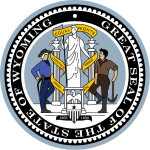This article relies largely or entirely on a single source .(November 2024) |
| |||||||||||||||||||||||||||||||
15 of 30 seats in the Wyoming Senate Odd-numbered seats up | |||||||||||||||||||||||||||||||
|---|---|---|---|---|---|---|---|---|---|---|---|---|---|---|---|---|---|---|---|---|---|---|---|---|---|---|---|---|---|---|---|
| |||||||||||||||||||||||||||||||
 Results by district | |||||||||||||||||||||||||||||||
| |||||||||||||||||||||||||||||||
| Elections in Wyoming |
|---|
 |
The 2002 Wyoming Senate election was held on November 5, 2002, to elect members to the Wyoming Senate for its 57th session as part of the 2002 United States elections. Partisan primaries were held on August 20. All odd-numbered seats were up for election. Neither party made any gains in the chamber. Of the fifteen seats up for election, only four saw Republicans and Democrats compete.